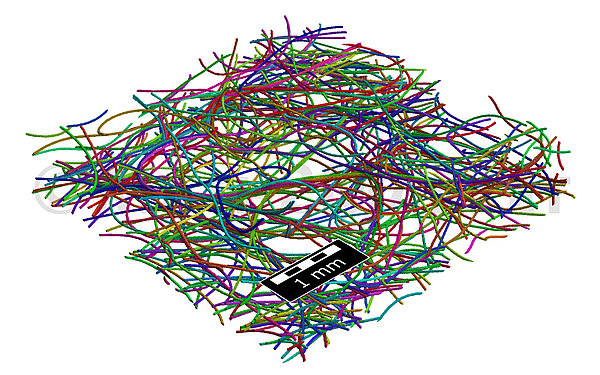Create the Digital Twin of a Nonwoven with GeoDict
Analysis of a nonwoven and modeling of a digital twin based on a µCT scan
The development of textiles plays an important role in almost all aspects of life. Nonwovens, unlike other technical materials, are characterized by their versatility, durability, absorbability, cost efficiency and simple production.
Depending on the application of the desired nonwovens, they must have a variety of different properties. In addition to the fiber type and the individual production parameters, the bonding type is also one of the characteristic properties.
In the following example, a nonwoven is simulated with GeoDict using a µCT scan and a digital twin is created. This digital twin can be used to calculate a wide range of mechanical and physical properties. Thus, the nonwoven can be optimized by varying and improving the digital model.
What were the results?
- Modeling a nonwoven by importing and then segmenting a µCT scan using ImportGeo-Vol.
- Performing a fiber analysis with the FiberFind module.
- Generation of a digital twin based on the FiberFind results.
- Calculation of the physical properties based on the µCT scan and the generated digital twin
Approach
In the first step, the µCT scan of the nonwoven is imported and post-processed using the ImportGeo-Vol module. More than 25 different image filters are available and the image parameters (e.g. size or alignment) can be changed. Afterwards, the µCT scan will be segmented.
- With ImportGeo-Vol, all required data can be loaded with just one click, as well as the desired voxel length can be individually adjusted.
- 3D images can be segmented quickly and easily, and the image quality can be subsequently improved using appropriate filters.
- Desired parameters, such as the selection of materials or the segmentation threshold, can be edited even after segmentation and the structure can be aligned or rotated accordingly.
- The generated microstructure can be displayed in overall and section views, as well as in 2D or 3D in GeoDict. This allows the microstructure to be viewed accurately from all directions.
Import of the µCT scan
µCT scans are simply imported into GeoDict with ImportGeo-Vol and displayed as gray-scale images. Transparency and gray scale range can be adjusted. For image processing of the gray scale image, ImportGeo-Vol provides numerous filters such as noise filters, sharpness filters, artifact filters and curtaining filters. However, the better the quality of the gray scale image, the faster and more precise the segmentation of the image will be in the next step.
For the segmentation, the threshold can be set either manually, automatically (Otsu or KMeans) or with the help of artificial intelligence.
Segment µCT scan
In the segmentation, a material ID is assigned to the fibers and a structure is obtained that can be used for any calculation or simulation needed. The fact that GeoDict works directly on voxel structures does not require any meshing of the fibers and simulations can be performed directly on the segmented microstructure.
Approach
For the generation of a digital twin, the structure of the nonwoven must first be analyzed. FiberFind-AI was used to perform a precise analysis of the geometric properties of the microstructure.
Then, based on the results of the analysis with FiberGeo, a digital twin of the microstructure was quickly and easily generated. Various simulations and calculations can then be performed on this digital twin. The digital twin is thus a valuable basis for the digital further development of the nonwoven.
Analysis of fibers with FiberFind-AI
The analysis of the segmented fibers with FiberFind-AI provides important information such as the fiber diameter, the fiber curvature, as well as the orientation of the individual fibers in the microstructure.
Generation of digital twin with FiberGeo
Based on the results from FiberFind-AI, a digital twin can now be automatically generated with FiberGeo.
Approach
After creating the structure, the properties of the nonwoven can be calculated directly and easily. Based on these results, one can compare the µCT scan and the digital twin. The fiber structure can be analyzed as well as various statistical characteristics can be evaluated. Furthermore, the physical properties of the twin and the original structure can be compared. In Fig. 7, for example, the permeability was calculated and compared.
Using FlowDict, the permeability tensor is obtained, as well as the values for the mean flow velocity at a given pressure drop, the estimated Reynolds number and the Gurley value in the selected calculation directions. In the results it is also possible to view the diagrams for the pressure, velocity and convergence.
We thank Reifenhäuser Reicofil GmbH & Co. KG for providing us to use the material like sample C for this GeoDict application.












